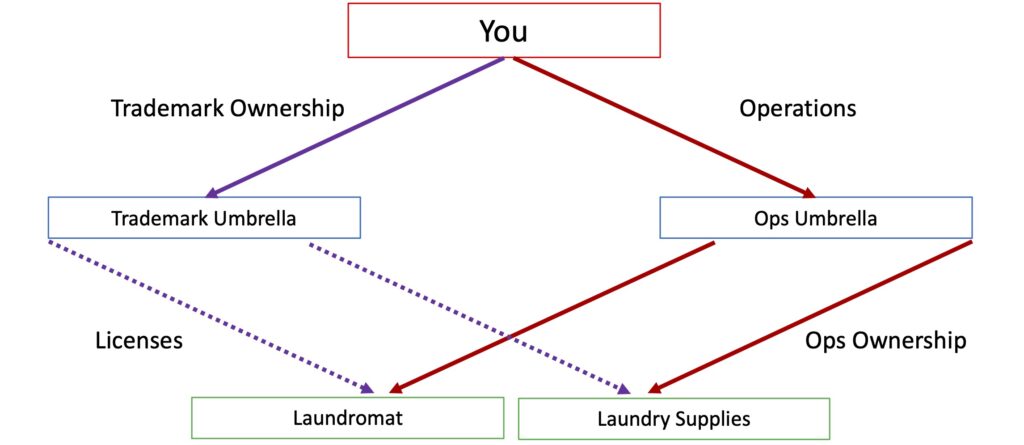Share Trademark With Multiple Companies
You own multiple companies, and you want them all to share use of a single emblem (be it a logo or a name) that is protected by trademark rights. How do you accomplish that? There are three ways, but first, what is a trademark legally?
What Is Trademark
Trademark is the form of intellectual property that protects brands from being misused. Trademark ownership rights come with a responsibility to the consuming public: The owner of a trademark must prohibit others from using the mark in connection with certain goods and services, without the owner’s permission. For example, no one may use the “Golden Arches” in connection with a restaurant except the McDonalds franchise owner and those other companies to which the franchise owner grants permission. That way the trademark owner can control quality and consumers can be sure that every restaurant displaying that mark (the Golden Arches) will serve food that is familiar to the consumer.
Now suppose you have two different companies that provide different but complimentary goods and services. For example, one company owns a series of laundromats, and the other company sells designer laundry supplies. For marketing purposes you want to associate a specific emblem (your “mark”) with both the laundromats and the laundry supplies. Here are three ways to do it.
One Trademark, One Owner, Multiple Licenses
In this solution you establish one specific individual or company to own the trademark that protects the emblem. That owner can be you personally, or it can be a company that you establish to control rights to using the emblem. Then that owner gives permission to the laundromat company and to the laundry supplies company. The “permission” is a contract called a “license” that spells out the conditions under which the each of those companies may continue to use the emblem in connection with their goods and services.
In particular, the licenses will probably stipulate that the laundromat company may use the emblem only in connection with laundromats, and the laundry supplies company may use the emblem only in connection with laundry supplies. The licenses may also restrict use to certain geographical territories, and they may provide that a royalty be paid to the owner of the trademark.
One Trademark, Multiple Owners
A trademark is legally a form of property, and it can have multiple owners like any other form of property. In this scenario, both companies could jointly own the rights to use the emblem for all the goods and services. No licenses are required, but as with any jointly owned property, there should be a contract among the trademark owners as to how each will use the trademark. That contract should also spell out what happens if control over one of the companies changes—for example you decide to sell the laundry supplies company but keep ownership of the laundromats.
Multiple Trademarks, Multiple Owners
In this solution, each of the companies applies for and gets trademark ownership of the same emblem, but the trademark ownership rights are restricted to different uses within the Trademark Office’s trademark registrations themselves. In this scenario no licenses are necessary, and each company may use its mark within its own lane.
Note: When the trademark office receives two applications from two different companies for trademark on the same emblem and to be used with complimentary goods and services, the trademark office would likely deny trademark rights to one of them. But you can specify in your application that the two companies share common ownership, which will let both trademark registrations go forward.
What Is The Best Approach?
The simplest approach seems to be the second one above, “One Trademark, Multiple Owners.” There’s only one trademark and the joint owners work things out. But joint ownership of any property by different entities (or individuals!) can be messy—as any siblings who’ve inherited the family summer house will know! There should be a very detailed contract among the joint owners setting forth the exact conditions under which each of the joint owners may use the mark. This will turn out to be similar in scope to a license agreement. Joint ownership would probably become a red flag to any prospective buyer of one of the companies, because here the trademark is not a uniquely owned asset. Furthermore, the limits on joint ownership are contained in the internal contract with the other joint tenant, and that contract may not be re-negotiable.
I like the approach of having One Trademark, One Owner, Multiple Licenses. The trademark itself has clear ownership obtained by a single application. The licenses with each company are a kind of asset for those companies, and the licenses may be independently negotiated between the trademark owner and each of the companies. The trademark owner can set up royalty arrangements separately with the two companies. Furthermore, a buyer of the laundromat company, for instance, might require that the trademark as used on laundromat services be sold to him along with the company. That requirement can be accomplished by transferring trademark ownership for that service only, without affecting the license to the laundry supplies company.
It’s almost as good to set up Multiple Trademarks with Multiple Owners. You’d probably want to do that if you certainly expect to sell one or the other company. That way trademark ownership is already part of the intellectual property of each company for the buyer. But this approach lacks the flexibility of creating licenses that are limited in geographical scope or some other restriction (such as that the license may be revoked if the licensee’s quality deteriorates).
Okay, let’s say you decide that you do want one trademark and use license(s) to allow the various companies to use the mark for specific goods. Is it better that you own the trademark individually or that you set up some company to own the trademark that gets licensed separately to the laundromat and the laundry supplies companies? There’s no correct answer to this, but I prefer to have my clients own business assets (the trademark is a business asset) through a company. If management of the asset(s) requires you to hire a manager, then the company does the hiring, not my client as an individual.
So, if there should be a company to own the trademark, then why not let it be either the laundromat or the laundry supplies company, why bother setting up an umbrella company to own the trademark? The answer lies in the two words that almost every entrepreneur holds dear: Control & Flexibility.
Look at the structure I propose in the diagram. Every box is a company that you can sell (or buy by adding the appropriate boxes and lines). Every colored line is a relationship that you can treat differently. The solid lines are ownership relationships, and the dotted lines are licenses. The purple lines relate to trademark, and the red lines relate to business operations. This structure gives you the maximum control and flexibility over your empire.

Summary
As you grow your business, you will need to consider the use of multiple companies and the allocation of multiple assets. One of the most important assets of any company is its brand identity, which is protected by the intellectual property call “Trademark.” By properly structuring the ownership of the companies and the assets (like trademark), you can achieve remarkable control and flexibility.
Entrepreneurs are going to save the world, and Argent Place® Law wants to help. Whether you are ready to start your own company now, or you are expanding your business, or you’re getting ready to sell your business, Argent Place Law can help you succeed. Think how great it will be to have a lawyer with entrepreneurial experience on your speed dial whom you can call up and say, “I want to use my trademark in several companies I own. How do I do that?” Schedule an appointment, or just call Argent Place Law to find out: 703-539-2518.

